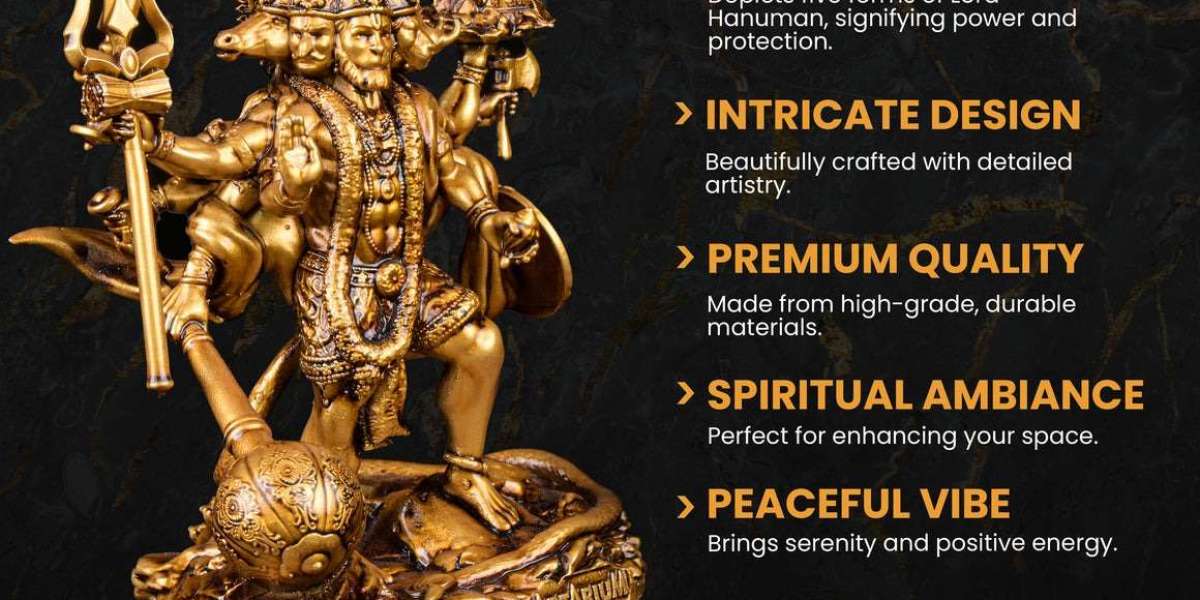Meaning and Symbolism of Panchmukhi Hanuman Ji Murti
The term "Panchmukhi" translates to "five-faced" in Sanskrit, where each face of the Panchmukhi Hanuman Ji Murti symbolizes distinct divine qualities and powers:
Hanuman Face: The central face represents Lord Hanuman himself, embodying strength, courage, and unwavering devotion to Lord Rama. It symbolizes determination, fearlessness, and the ability to overcome adversities.
Narasimha Face: The lion-faced form symbolizes protection and valor. It represents the ferocious aspect of Lord Vishnu and instills courage and fearlessness in devotees.
Garuda Face: The eagle-faced form of Garuda, Lord Vishnu's mount, signifies speed, agility, and swift action. It symbolizes the ability to swiftly navigate through challenges and obstacles.
Varaha Face: The boar-faced form of Varaha symbolizes rescue and protection. It signifies the power to lift and remove obstacles that hinder spiritual and material progress.
Hayagriva Face: The horse-faced form of Hayagriva embodies wisdom and knowledge. It encourages seekers to pursue education, seek spiritual enlightenment, and make wise decisions in life.
The amalgamation of these faces in the Panchmukhi Hanuman Ji Murti underscores Lord Hanuman's multifaceted nature and highlights his role as a protector, guide, and source of strength for devotees.
Mythological Significance
The origins of the Panchmukhi Hanuman Ji Murti are deeply rooted in Hindu scriptures, particularly the Ramayana and the Mahabharata. It is believed that during the battle between Lord Rama's army and the demon king Ravana, Lord Hanuman assumed the Panchmukhi form to overcome powerful adversaries and protect righteousness (Dharma). Each face of the murti represents a specific divine manifestation, offering devotees blessings and protection in various aspects of life and spiritual pursuits.
Cultural Relevance and Devotional Practices
The worship of the Panchmukhi Hanuman Ji Murti holds significant cultural and spiritual importance in Hindu traditions:
Artistic Representations: Skilled artisans craft Panchmukhi Hanuman Ji Murtis with intricate details, reflecting the rich artistic heritage of Hindu iconography. These murtis adorn temples, homes, and sacred spaces, serving as focal points for devotion and reverence.
Festivals and Rituals: Devotees celebrate festivals such as Hanuman Jayanti with profound devotion. Special rituals, prayers, and offerings are made to the Panchmukhi Hanuman Ji Murti, seeking blessings for courage, protection, and spiritual growth.
Personal Devotion: Many individuals keep Panchmukhi Hanuman Ji Murtis in their homes or personal altars. Daily prayers, recitation of Hanuman Chalisa, and meditation create a deep spiritual connection and invoke the murti's presence.
Spiritual Teachings and Lessons
Worshiping the Panchmukhi Hanuman Ji Murti imparts valuable spiritual teachings:
Devotion and Loyalty: It exemplifies unwavering devotion and loyalty to a higher ideal or purpose, inspiring devotees to remain steadfast in their faith and devotion to Lord Hanuman.
Strength and Courage: The murti symbolizes strength, courage, and resilience in facing life's challenges. It serves as a source of inspiration and motivation during difficult times, encouraging devotees to persevere with faith.
Wisdom and Knowledge: The Hayagriva face of the murti encourages seekers to pursue knowledge, wisdom, and spiritual enlightenment. It emphasizes the importance of education, spiritual growth, and making informed decisions in life.
Contemporary Relevance
In modern times, the Panchmukhi Hanuman Ji Murti continues to resonate deeply with devotees worldwide:
Global Devotion: The murti's symbolism and teachings transcend geographical boundaries, attracting devotees from diverse cultural backgrounds who seek spiritual guidance, protection, and blessings.
Digital Presence: Online platforms offer resources and information about Panchmukhi Hanuman Ji, enabling devotees to deepen their understanding and practice of devotion through virtual puja services, educational materials, and community forums.
Symbol of Strength and Protection: The murti symbolizes not only spiritual strength and protection but also serves as a cultural icon that reinforces faith, unity, and shared spiritual values among devotees.
Conclusion
The Panchmukhi Hanuman Ji Murti, with its profound symbolism, mythological roots, and spiritual teachings, stands as a timeless symbol of devotion, courage, and divine protection in Hinduism. As a representation of Lord Hanuman's multifaceted attributes and divine manifestations, the murti inspires faith, fosters devotion, and offers solace to millions of devotees worldwide. Its presence in temples, homes, and sacred spaces serves as a constant reminder of Lord Hanuman's grace, strength, and unwavering commitment to righteousness. Thus, the Panchmukhi Hanuman Ji Murti remains a cherished embodiment of spiritual belief, cultural heritage, and profound devotion in the hearts and minds of devotees across generations.









